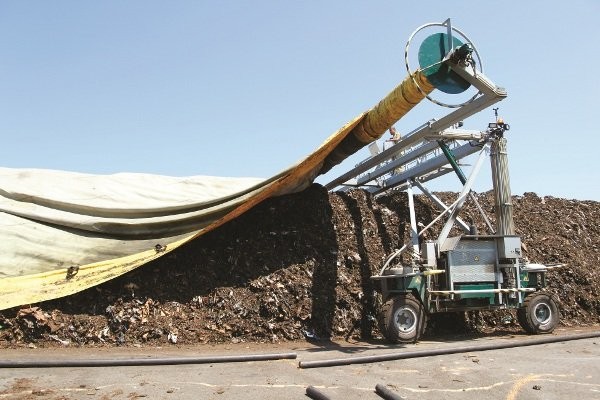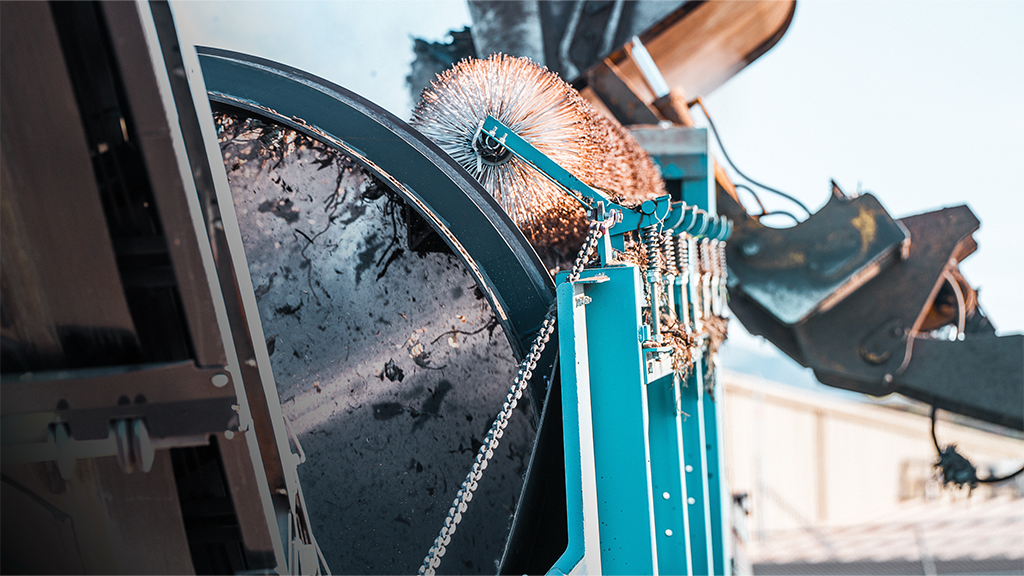A model facility
The right building and an advanced process pave the road to success in Delaware

A little bit of “magic” happens every day at the Wilmington Organic Recycling Center (WORC). Truckloads of food yard and other organics come in; tons of high-quality compost, mulch and topsoil go out.
“Recycling organic waste isn’t a fad. It’s a strong movement that is unstoppable,” says Nelson Widell, marketing and sales director of Peninsula Compost Group, the company that owns and operates the recycling centre in Wilmington, Delaware.
Widell co-founded the company with Charles Gifford in 2006 to develop and operate large-scale food waste composting facilities. The partners, both with 30-plus years in the waste industry, were invited at that time by the state of Delaware to explore opportunities to develop a composting facility. Peninsula teamed up with Port Contractors, an East Coast material handling company, and EDiS Company, an authorized, local Butler Manufacturing builder, to develop their first project: a large-scale food and yard waste composting facility.
“The impetus was the wave of demand for organic recycling – separating food and yard waste from the waste stream and diverting it from landfills,” Widell said. “And in some instances, like Delaware, states have banned yard waste from landfills.”
“We were ready to seek financing and the financial crisis hit,” says E. Andrew DiSabatino Jr., president and CEO, EDiS. “Being an environmentally conscious company, it was a technology that we were interested in embracing ourselves. So we stepped up as a financial partner and helped find the investors to make it happen.”
Smoothing the way
The 27-acre site chosen for WORC was an industrially zoned brownfield, located on the outskirts of town and easily accessible from some of the most heavily travelled roads in the country. The site is also in a flood plain, so EDiS says they did extensive site work, adding about two feet of fill to protect the site from flooding. The site is also adjacent to a densely populated, low-income neighbourhood. Peninsula reached out to community leaders right away.
“If you don’t have the support of your neighbourhood, you’re doomed from the beginning,” says Widell.
Peninsula took a delegation to tour two similar facilities in Massachusetts and Seattle, Washington. As a result, fears about the operation – especially odours – were assuaged. The parties then negotiated a community-benefits agreement, the first ever in the state of Delaware. The agreement put in writing a number of guarantees, including the ban of trucks driving through the neighbourhood, minority participation in construction, full-time jobs for residents and a 24-hour hotline to report odours, which, Widell says, has never rung.
The construction The WORC setup appears fairly simple. Trucks drive into a building, dump a load of food or yard waste, then drive off. Inside, workers sort and grind the waste into a recipe that mixes wood, food and yard waste with nitrogen, oxygen and moisture, producing optimum conditions for creating compost. The churned mixes are then transported outside to a series of windrows. While it seems small in comparison to the operation, Widell says the building is crucial to the process.
The Peninsula Compost Group considered several types of buildings before settling on Butler Manufacturing.
“The cost to construct, which was a big part of the decision, made Butler systems ideal for the job,” says Brian Schaffer, executive vice president and general manager of the recycling center. “I was most impressed with the ease of construction. Once the foundation was poured, it went up very fast.”
The main part of the building installed at WORC is 125 feet square and stands 40 feet at the ridge. A smaller, shorter 3,125-square-foot section houses office space and mechanicals. EDiS chose the Butler Widespan structural system in order to create a column-free interior.
“The big dump trucks drive in and tip the back of their trucks to dump the waste,” explains DiSabatino. “That’s why it has to be so tall.” The main section also holds the giant shredder used to break down and mix the materials.
“It’s like a kitchen mixer on steroids; it can cut a tree trunk in half,” DiSabatino adds.
Waste products create a damp, corrosive environment, so EDiS recommended galvanized steel to prevent rust and save maintenance costs.
“All of the building frames were made from galvanized materials – which means no rust, no repainting, no coatings, ever,” DiSabatino says.
“With Butler, that was not a problem. And it looks as good today as it did when we erected it.”
The building is topped with a Butler II roof system with a white “cool roof” finish system to reduce the amount of heat reflected into the atmosphere. EDiS also uses Butler’s Sky-Web fall protection and insulation support system, a unique mesh that offers workers protection from falls and also remains in place after construction to support ceiling insulation.
Green use, green building
Given its end use, it only made sense to make the building at WORC as green as possible.
“We always recycle construction waste. Using galvanized steel eliminated the need for finishes. And the Butler systems are inherently green – from the use of recycled and recyclable steel to the cool roof and reduced energy costs,” DiSabatino says.
To reduce the facility’s carbon footprint, all of the process machinery is powered by electricity rather than diesel fuel. And to reduce the need for interior lights, dozens of Butler LitePanl translucent roof and wall panels were inset into the building envelope.
“We are on the forefront of organics recycling. We want to practice what we preach,” Schaffer said. In fact, he says, the whole facility has been certified to sell carbon credits – up to 100,000 a year. By diverting food and yard waste from landfills where it would produce methane gas, WORC reduces greenhouse gas emissions by the equivalent of about 8,800 cars per year.
The Butler building also uses a negative air system and biofilter for odour control, while a leachate collection system collects and disposes of excess liquids that could harm the environment.
A significant impact
The facility was up and running in just nine months, and the partners dedicated it earlier this year on Earth Day. Today, 20 WORC employees process about 400 to 450 tons of food waste a day – up to 160,000 tons a year – producing 140,000 tons of nutrient-rich compost and other soil products annually.
Plus, contracts with every major hauling company in the region bring leftovers and trimmings from any institution dealing with food, from schools and prisons to grocery stores. Finished compost products are sold by the bucketful to residents or by the truckload to landscapers, home garden centres and other commercial enterprises.
The project has been so successful that Peninsula recentl y took on Waste Management, Inc. as an investor. They are now developing similar facilities in Chicago, Massachusetts, New Jersey, Florida and Maryland.
“We will definitely use Butler systems again. The building has been better than expected. We are very pleased with the building, and EDiS has been extraordinary to deal with. They are top-rate,” Widell concluded.


